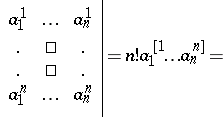Alternation
skew symmetry, anti-symmetry, alternance
One of the operations of tensor algebra, yielding a tensor that is skew-symmetric (over a group of indices) from a given tensor. Alternation is always effected over a few superscripts or over a few subscripts. A tensor  with components
with components  is the result of alternation of a tensor
is the result of alternation of a tensor  with components
with components  , for example, over superscripts, over a group of indices
, for example, over superscripts, over a group of indices  if
if
 | (*) |
The summation is conducted over all  rearrangements (permutations)
rearrangements (permutations)  of
of  , the number
, the number  being
being  or
or  , depending on whether the respective rearrangement is even or odd. Alternation over a group of subscripts is defined in a similar manner.
, depending on whether the respective rearrangement is even or odd. Alternation over a group of subscripts is defined in a similar manner.
Alternation over a group of indices is denoted by enclosing the indices between square brackets. Secondary indices inside the square brackets are separated by vertical strokes. For instance:
 |
Successive alternation over groups of indices  and
and  ,
,  , coincides with alternation over the group of indices
, coincides with alternation over the group of indices  :
:
 |
If  is the dimension of the vector space on which the tensor is defined, alternation by a group of indices the number of which is larger than
is the dimension of the vector space on which the tensor is defined, alternation by a group of indices the number of which is larger than  will always produce the zero tensor. Alternation over a given group of indices of a tensor which is symmetric with respect to this group (cf. Symmetrization (of tensors)) also yields the zero tensor. A tensor that remains unchanged under alternation over a given group of indices
will always produce the zero tensor. Alternation over a given group of indices of a tensor which is symmetric with respect to this group (cf. Symmetrization (of tensors)) also yields the zero tensor. A tensor that remains unchanged under alternation over a given group of indices  is called skew-symmetric or alternating over
is called skew-symmetric or alternating over  . Interchanging any pair of such indices changes the sign of the component of the tensor.
. Interchanging any pair of such indices changes the sign of the component of the tensor.
The operation of tensor alternation, together with the operation of symmetrization, is employed to decompose a tensor into simpler tensors.
The product of two tensors with subsequent alternation over all indices is called an alternated product (exterior product).
Alternation is also employed to produce sign-alternating sums of the form (*) with multi-indexed terms. For instance, a determinant with elements which commute under multiplication can be computed by the formulas
 |
 |
References
| [1] | P.A. Shirokov, "Tensor calculus. Tensor algebra" , Kazan' (1961) (In Russian) |
| [2] | D.V. Beklemishev, "A course of analytical geometry and linear algebra" , Moscow (1971) (In Russian) |
| [3] | J.A. Schouten, "Tensor analysis for physicists" , Cambridge Univ. Press (1951) |
| [4] | N.V. Efimov, E.R. Rozendorn, "Linear algebra and multi-dimensional geometry" , Moscow (1970) (In Russian) |
Alternation. Encyclopedia of Mathematics. URL: http://encyclopediaofmath.org/index.php?title=Alternation&oldid=45091